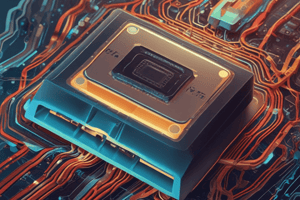Podcast
Questions and Answers
What is the primary difference between a Power BJT and a signal BJT?
What is the primary difference between a Power BJT and a signal BJT?
What is the region in which the collector current is almost zero?
What is the region in which the collector current is almost zero?
What is the purpose of connecting a diode in series with the collector?
What is the purpose of connecting a diode in series with the collector?
What is the consequence of high power loss during turn-on or turn-off?
What is the consequence of high power loss during turn-on or turn-off?
Signup and view all the answers
What is the characteristic of a Power BJT that makes it a current-controlled device?
What is the characteristic of a Power BJT that makes it a current-controlled device?
Signup and view all the answers
What is the primary requirement for a Power BJT to emulate an ideal switch?
What is the primary requirement for a Power BJT to emulate an ideal switch?
Signup and view all the answers
What is the term used to describe the maximum voltage between collector and emitter in the cutoff region?
What is the term used to describe the maximum voltage between collector and emitter in the cutoff region?
Signup and view all the answers
What is the primary advantage of Power BJTs over other devices?
What is the primary advantage of Power BJTs over other devices?
Signup and view all the answers
What is a significant difference between Power BJT and signal BJT?
What is a significant difference between Power BJT and signal BJT?
Signup and view all the answers
Power BJTs can block negative collector-emitter voltages.
Power BJTs can block negative collector-emitter voltages.
Signup and view all the answers
What happens when both the collector-emitter voltage and the collector current are high?
What happens when both the collector-emitter voltage and the collector current are high?
Signup and view all the answers
The operation of a Power BJT is controlled by its ______________ gain.
The operation of a Power BJT is controlled by its ______________ gain.
Signup and view all the answers
Match the following characteristics of Power BJTs:
Match the following characteristics of Power BJTs:
Signup and view all the answers
Power BJTs have been completely replaced by other devices.
Power BJTs have been completely replaced by other devices.
Signup and view all the answers
What is the primary requirement for a Power BJT to operate in the on-state?
What is the primary requirement for a Power BJT to operate in the on-state?
Signup and view all the answers
Study Notes
Power BJT: Bipolar Junction Transistor
- First SCSD (Self-Controlled Switching Device) that allows full control
- Many other devices classified as "Transistors" have been developed, almost replacing BJTs
Construction and Operating Characteristics
- Power BJT differs significantly from signal BJT due to voltage and current ratings requirements
- In the cutoff region, base current (iB) ≤ 0 and collector current is almost zero
- Maximum voltage between collector and emitter under this condition is denoted by VCEO (the rated voltage)
Emulating an Ideal Switch
- High base current in the on-state is required for the operating point to lie on the hard saturation line
- Associated with the lowest voltage drop across the device
Voltage Blocking
- BJTs cannot block negative collector–emitter voltages
- A diode connected in series with the collector is required to block negative voltage
Second Breakdown
- Occurs when both collector–emitter voltage and collector current are high, during turn on or turn-off
- Results in high power loss, local hot spots appear in the semiconductor
- Current density increases in hot spots, leading to damage
BJT Characteristics
- Current-Controlled Device
- Low current gain compared to signal amplifiers (around 10)
Power BJT: Bipolar Junction Transistor
- First SCSD (Self-Controlled Switching Device) that allows full control
- Many other devices classified as "Transistors" have been developed, almost replacing BJTs
Construction and Operating Characteristics
- Power BJT differs significantly from signal BJT due to voltage and current ratings requirements
- In the cutoff region, base current (iB) ≤ 0 and collector current is almost zero
- Maximum voltage between collector and emitter under this condition is denoted by VCEO (the rated voltage)
Emulating an Ideal Switch
- High base current in the on-state is required for the operating point to lie on the hard saturation line
- Associated with the lowest voltage drop across the device
Voltage Blocking
- BJTs cannot block negative collector–emitter voltages
- A diode connected in series with the collector is required to block negative voltage
Second Breakdown
- Occurs when both collector–emitter voltage and collector current are high, during turn on or turn-off
- Results in high power loss, local hot spots appear in the semiconductor
- Current density increases in hot spots, leading to damage
BJT Characteristics
- Current-Controlled Device
- Low current gain compared to signal amplifiers (around 10)
Studying That Suits You
Use AI to generate personalized quizzes and flashcards to suit your learning preferences.
Related Documents
Description
Learn about the construction and operating characteristics of Power BJTs, including their differences from signal BJTs and their voltage and current ratings. Understand the cutoff region and maximum voltage between collector and emitter.




